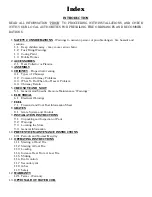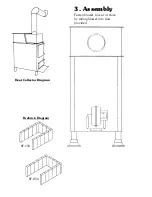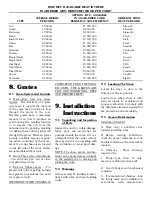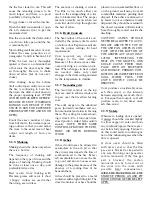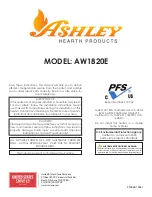
6
NOTE: The Chimney on the house
illustrated is too low. It should be
raised to compensate for drafts.
E. Chimney Size - Chimney is not
properly sized to adequately vent
the appliance. It is either too small
or too large.
F. Chimney Offsets - Chimneys
with offsets should not be used.
They cause an obstruction to draft
as well as a place for debris to col-
lect.
G. Elbow Restrictions - The flue
pipe is connected to the chimney
with too many elbows, reducing the
draft the chimney can provide.
H. Multiple Venting - No more than
one device shall vent into the same
chimney flue.
THE MOST IMPORTANT THING
TO REMEMBER ABOUT CHIM-
NEYS IS THEIR NEED FOR MAIN-
TENANCE AND CLEANING. IF
CHIMNEYS ARE NOT CLEANED
ON A FREQUENT BASIS, IT WILL
AFFECT THE DRAFT, AS WELL
AS BEING A CONTRIBUTING
CAUSE TO A CHIMNEY FIRE.
CAUTION
ANYTIME YOU HAVE A CHIM-
NEY FIRE THE FOLLOWING
POINTS
SHOULD
BE
OBSERVED:
1. BE SURE EVERYONE IS OUT
OF THE HOUSE.
2. CALL THE FIRE DEPA RT-
MENT.
3. CLOSE
DOWN
DRAFT
DAMPER ON STOVE.
AFTER THE FIRE IS EXTIN-
GUISHED, DO NOT USE THE
CHIMNEY UNTIL A QUALIFIED
PERSON HAS INSPECTED YOUR
CHIMNEY.
4.3 What To Do When You
Have A Problem
A. Smoke Puffs From Your
Stove:
1. Check the chimney draft. With a
good fire burning, the chimney
should supply .06" updraft.
2. Check draft controls for proper
operation.
3. Check the smoke pipe and be
sure it is clean.
4. Chimney may be too low.
Increase the height. Make sure the
chimney is structurally sound.
5. Add more air to the room. Your
home may be so airtight that not
enough oxygen is reaching the fire.
6. REMEMBER, open the draft
controls and crack the fire door
slightly before recharging the fire
chamber or checking the fire.
SPECIAL WARNING: NEVER
OPERATE YOUR STOVE WITH
THE FIRE OR ASH DOOR OPEN!
7. Check the smoke pipe and
make certain each joint is tight and
the connections to the stove and
chimney are airtight.
8. Check the ashes. Ashpan and
f i re compartment may be over-
loaded with ashes.
9. Check type of wood being
burned. If too green or wet wood is
being used, it may cause excessive
smoking and creosote.
10. Check your chimney for down
drafts. This is caused by air currents
being deflected down the chimney
from higher objects, such as trees,
building and hills. This problem can
usually be corrected with an open-
vented chimney cap.
11. Make sure the chimney clean-
out door is tightly closed and sealed.
12. If other fuel-burning devices are
connected to the chimney they may
be causing draft problems. This
must be corrected by your heating
contractor.
4.4 Chimney Details
Chimney Liners - Most of the cus-
tomer inquiries received are prob-
lems caused by poor, or in some
cases, excessive draft. A result of
poor draft could be creosote, back-
puffing, and smoky firebox when
loading. Indications of excessive
draft are burning too much fuel and
high stack temperatures.
Figure 3
RECOMMENDED SIZING CHIMNEY FLUE LINERS
FURNACE COLLAR
CHIMNEY LINER
INSIDE
DIAMETER
AREA
ROUND
SQ. OR
DIMENSION
AREA
EQUIV.
(SQ. IN.)
ID
RECT.
(APPROX.)
(SQ. IN.)
DIA
6"
28.3
6"-7"
8" x 8"
6 1/2" x 6 1/2"
42.7
7.4"
7"
38.3
7"-8"
8" x 8"
6 1/2" x 6 1/2"
42.7
7.4"
8"
50.3
8"-9"
8" x 12"
6 1/2" x 10 1/2"
63.6
9"
Summary of Contents for SF-150 SF-250
Page 18: ...17...



